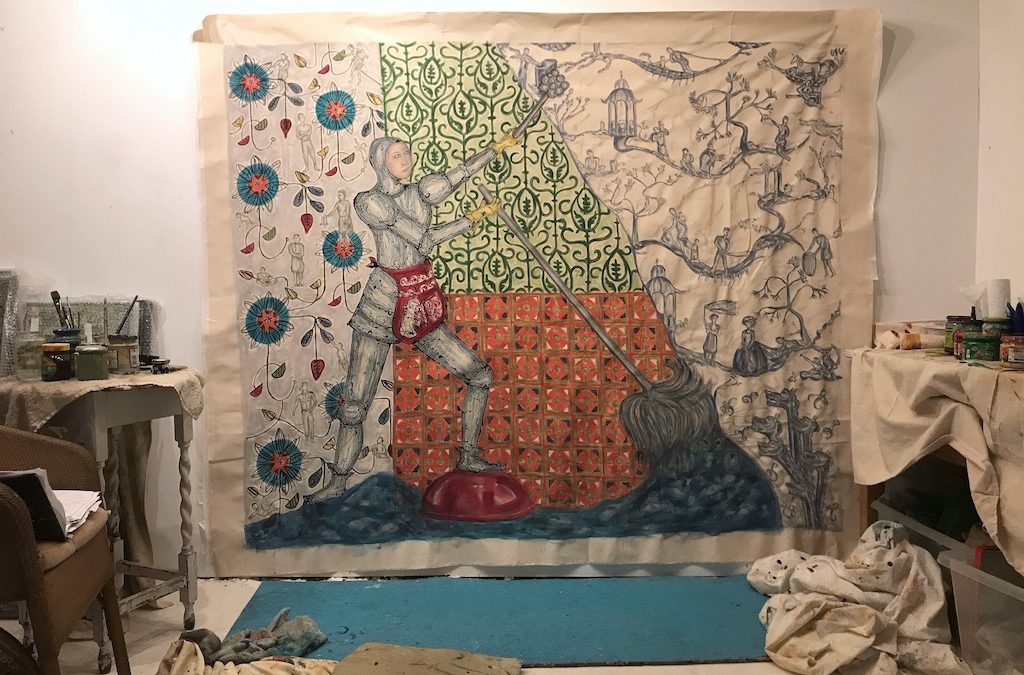Whilst working on this painting in the studio this year I have written some thoughts on using medieval symbols and patterns in my painting practice. Do have a read and let me know what you think.
Some thoughts on medievalesque contemporary painting
For some years I’ve been making figurative paintings that aim to evoke the human condition, especially the continued plight and inequality of women and carers, who are often the very lowest paid in society. Current paintings are fuelled by a dark fascination for medieval imagery, patterns, and symbolism. Is it just me, or is there a revival of interest in medieval imagery in contemporary painting? Artists constantly dip their toes in the lake of historical painting and with cyclical ‘returns’ (Hal Foster) to styles and historical art movements, perhaps this renewed interest is a natural ‘return’, or are there other reasons for this medieval zeitgeist?
Perhaps the medieval period (c. 500-1500) with its frequent recurrence of plagues seems closer to us and more resonant since the Pandemic. As the ‘danse macabre’ of life and death becomes reality, we are reminded of the equalising forces of death and mortality. Perhaps it simply makes us realize that we have so much more in common with the humanity of the past, than we thought.
Medieval societies were rule bound, patriarchal, unequal. Modern society prides itself on equality, yet Pandemic statistics reminded us of how much life expectancy is based on status and income. Seeing the medieval period as a mirror, it is natural to take another look at Bakhtin’s theories of medieval carnivalesque as an ironic equalising force.
Mikail Bakhtin’s writings about medieval folk cultures inspired philosophers from the 60s onwards (significantly Julia Kristeva). He proposed that carnivals and festivals brought together the most unlikely people. In addition to encouraging interactions between high and low born, carnivals united all in celebration, rather than condemnation and judgement. In the inside-out world of the carnival anything was possible. Eccentric behaviour could be revealed without consequence and Bakhtin proposed that a bi-product of inverting the usual societal divisions allowed a kind of grotesque realism that invoked laughter; laughter as a therapeutic and liberating force that degrades power relations.
The notion of the ‘carnivalesque’ is a potent force in allowing invisible and voiceless masses representation. It is a powerful idea that over the 20th and 21st centuries has influenced figurative painting as a social and political act (look at writing by Tim Hyman). I find this a very encouraging reason to make figurative paintings that brim with figures and bizarre medievaleque imagery – and to paint women into new historical frameworks.
Originally a student of history, I moved to Cornwall for many reasons, yet perhaps it is not a coincidence that I now live cheek by jowl with medieval imagery. I live next to a church with marvellous ancient carvings, including a carving of a merman. Less well known than the famous mermaid carving of Zennor, it is nice to know that for once that history favours a story about a woman.
Half-women, half-beast symbolism is a complex representation of duality and female metamorphic potential. Every culture has a version of these female deities, often carved with beautiful curving lines with other strange animals and symbols. Medieval society and the church often appropriated such symbols for a largely illiterate populace to expound ideas about a woman’s place. As Edwin Mullin explains,
‘There can only one origin of so pervasive a desire to control woman, abuse woman, to set her up to tear her down, enclose her in a labyrinth of moral strictures with so many blind exist she will never be free – and that is fear’.
Medieval symbolism is powerful and fearful. Every illuminated text, painting or tapestry is full of arcane references that seem hard to penetrate and understand and in strict male-dominated medieval societies, female symbols, like the mermaid, were constantly in flux, inherently contradictory – powerful, evil, and frightening.
‘Old as new’ is a renewal of meaning through appropriating and re-imaging familiar imagery. This is an old idea from Heraclitus law of enantiodromia (c. 500BC). He declared not only that old is new that eventually everything becomes its opposite. As ancient symbols morph and change, meanings and representation can be manipulated to promote new ways of looking at things.
Denigrating and debasing imagery of powerful female symbols (like mermaids) can be understood to be part of a timeless propaganda campaign that confined women’s power. Feminist artists of the 60s and 70s reinvested in old symbolism in order to create new iconographies, realising that symbols are a mould in which the meanings of male dominated culture are poured. As Griselda Pollock writes
‘the very signs and meanings of art in our cultures have to be ruptured and transformed because traditional iconography works against women’s attempts to represent themselves.’
The past is a mirror to observe our own times, and as we learn from what has gone before, it is a touchstone for the present. As a lens that enables us to look at things differently, it is the very contradiction of using medieval symbolism to promote visibility and equality for women now that appeals to my sense of humour. There is easy satire in raiding a medieval treasure chest for iconography and symbolism. Medieval art is deceptively simple. This simplicity is broken by swathes of dark humour and imagination (like that used in marginalia on the edges of manuscripts).
It is idyllic to think that the vast networks of symbolism for each animal, flower, tree or object, is an insight into a different world. Yet what is truly disturbing, is how little some things have changed. Medieval imagery is resonant and ripe, ready for playful carnivalesque humour in contemporary painting, that promotes equality and aims to be an agent of social change.
DELPHA HUDSON FEBRUARY 2022
This will be added to other writing on my writing page
